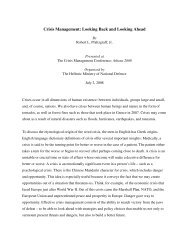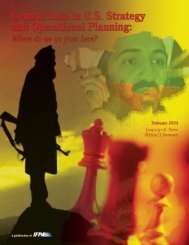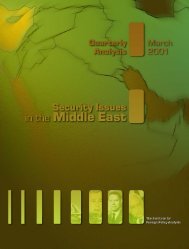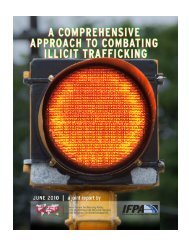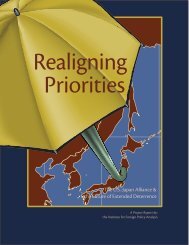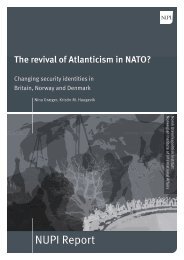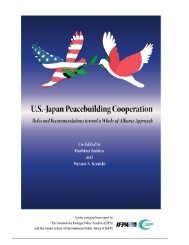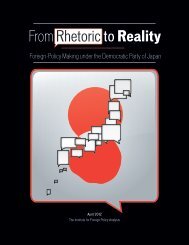US Peacebuilding in Afghanistan - Institute for Foreign Policy Analysis
US Peacebuilding in Afghanistan - Institute for Foreign Policy Analysis
US Peacebuilding in Afghanistan - Institute for Foreign Policy Analysis
Create successful ePaper yourself
Turn your PDF publications into a flip-book with our unique Google optimized e-Paper software.
U.S. DDR Activities <strong>in</strong> <strong>Afghanistan</strong>The DDR program <strong>in</strong> <strong>Afghanistan</strong>, begun <strong>in</strong> 2002 under the direction of Japan and the UNDevelopment Program (UNDP), aimed specifically at militias that had been part of or associatedwith the Northern Alliance dur<strong>in</strong>g the Afghan civil war. Under the umbrella of the Afghan NewBeg<strong>in</strong>n<strong>in</strong>gs Program (ANBP), the DDR program was run <strong>in</strong> conjunction with the Afghan MoDand at first federalized the militias <strong>in</strong>to the <strong>in</strong>itial elements of the ANA to <strong>for</strong>m the AfghanMilitary Force (AMF) (this plan was eventually abandoned <strong>in</strong> favor of the U.S. plan to raise theANA from scratch) and to demobilize 50,000 AMF members. 17 The program was scheduled <strong>for</strong>a five-year duration with the <strong>in</strong>tent to remove weapons from <strong>Afghanistan</strong> and either transitionAMF members <strong>in</strong>to the ANA or ANP or retra<strong>in</strong> them <strong>for</strong> civilian occupations. ANBP facedmany challenges from the start. One ma<strong>in</strong> issue was the fact that DDR was not discussed as partof the Bonn Agreement or UNSCR 1386 and was <strong>in</strong>stead agreed upon by the AMF commandersand <strong>in</strong>ternational partners at the donors’ conference <strong>in</strong> Geneva <strong>in</strong> 2002. This immediatelyexcluded armed groups <strong>in</strong> the west and south of <strong>Afghanistan</strong> as the Afghan voices at theconference were only those from the AMF and excluded those from the problematic Pashtunregions on the Pakistani border.As the AMF commanders were part of the plann<strong>in</strong>g and decision mak<strong>in</strong>g to <strong>in</strong>itiate the DDRprocess, they used their <strong>in</strong>fluence to ensure that they benefited from the program politically,monetarily, or militarily. Initially, the AMF commanders had <strong>in</strong>flated the number of combatantsunder their command to the <strong>in</strong>ternational community <strong>in</strong> order to <strong>in</strong>crease their share of DDR aid.This became problematic when DDR implementers realized this and were then required todecrease the number of combatants to support through the program, 18 a situation thatdisillusioned many combatants towards the program. 19 Regional biases persisted with<strong>in</strong> the AMFso that the most powerful militias received a disproportionate amount of DDR assistance, asdepicted <strong>in</strong> the figure below which shows the disparity <strong>in</strong> assistance by prov<strong>in</strong>ce. This chartprovides a visual example of how the ANBP focused on a small area of the country.Additionally, funnel<strong>in</strong>g DDR aid through the militia commanders also precluded a communitybasedapproach to DDR (a fairer system of DDR) and allowed those who commanded the gunsto decide which guns to give up and where.17 Simonetta Rossi and Antonio Giustozzi, “Disarmament, Demobilization and Re<strong>in</strong>tegration of Ex-Combatants <strong>in</strong><strong>Afghanistan</strong>: Constra<strong>in</strong>ts and Limited Capabilities,” London School of Economics, Crisis States Research Center,June 2006, 4.18 One estimate states that fully 80 percent of the persons registered <strong>for</strong> DDR were not actually combatants. SeeShamsul Hadi Shams, “Assess<strong>in</strong>g the Role of DDR <strong>in</strong> <strong>Afghanistan</strong>: Internal Security Provision and ExternalEnvironment,” <strong>in</strong> Toward Br<strong>in</strong>g<strong>in</strong>g Stability <strong>in</strong> <strong>Afghanistan</strong>: A Review of the <strong>Peacebuild<strong>in</strong>g</strong> Strategy, ed. YujiUesugi (Hiroshima: <strong>Institute</strong> <strong>for</strong> Peace Science Hiroshima University, 2010), 62.19 Shams, 62.7




